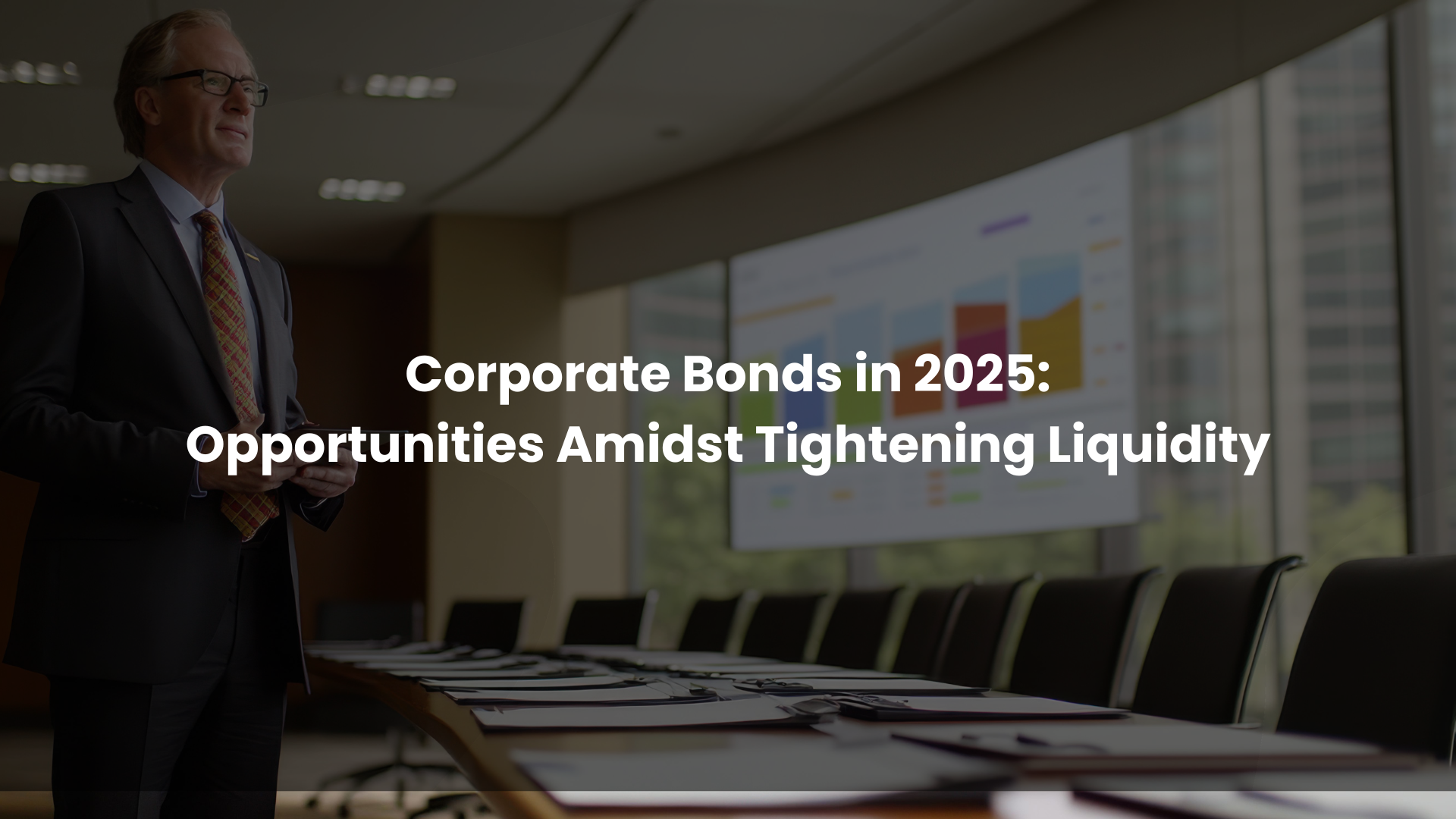The global corporate bond market in 2025 stands at a pivotal moment — shaped by tightening liquidity conditions, evolving regulatory frameworks, and advancing digital access that is redefining how investors engage with debt markets. While challenges remain, notably from higher funding costs and volatile interest rate environments, the asset class continues to present compelling opportunities for investors who prioritise credit quality, duration management, and transparency.
This year has underscored a central truth of fixed-income investing: even amid liquidity strains, disciplined allocation and informed positioning can yield steady, risk-adjusted returns.
Global Market Overview: Mixed Performance but Stable Momentum
The performance of global corporate bonds through 2025 has been mixed, reflecting diverging central bank policies, uneven growth trajectories, and shifting investor sentiment. High-yield bonds have outperformed U.S. Treasuries, driven by higher coupon income, while investment-grade corporate debt has delivered modest but stable returns.
In contrast to equities, corporate bonds have benefited from investor preference for predictable income streams during a period of macroeconomic uncertainty. With interest rates in the United States and Europe likely peaking, global investors have been recalibrating their fixed-income portfolios — favouring shorter maturities, quality issuers, and regions offering relative value.
The dynamics in Asia, and particularly India, have been noteworthy. The Indian corporate bond market reached an estimated ₹51.5 trillion in outstanding value by late FY25, supported by record issuance levels and an expanding investor base. This growth underscores the country’s maturing capital markets and the increasing willingness of corporates to diversify funding sources beyond traditional bank lending.
Tightening Liquidity: The Dominant Theme of 2025
Despite strong issuance and structural progress, the tightening of liquidity across banking systems has emerged as the key challenge for bond markets this year.
In India, for example, October 2025 saw liquidity pressures intensify due to a combination of tax outflows, festive season credit demand, and cautious interbank lending. These factors have collectively pushed yields higher and bond prices lower, with the benchmark 10-year government bond yield rising to around 6.54%. The ripple effect on corporate borrowing costs has been inevitable.
However, while liquidity has tightened, it has not deteriorated. The Reserve Bank of India’s neutral monetary policy stance has provided a stabilising anchor, preventing an uncontrolled surge in rates. This “selective tightness” — where funding becomes more expensive but remains accessible for quality issuers — has created a market environment that rewards discipline and strategic positioning.
Opportunities Amidst the Strain
Even as liquidity tightens, the 2025 corporate bond landscape presents several opportunities that are structural rather than cyclical. Investors who can navigate the evolving terrain stand to benefit from both yield enhancement and improved transparency.
1. Regulatory Support and Market Reform
Reforms spearheaded by the Securities and Exchange Board of India (SEBI) have materially strengthened the foundation of the corporate bond market. Measures such as enhanced disclosure norms, the introduction of electronic bidding platforms, and a unified Know Your Customer (KYC) process have reduced friction and improved confidence among both institutional and retail participants.
These steps are helping build a more transparent, efficient, and accessible fixed-income ecosystem — crucial for deepening market participation and encouraging foreign inflows.
2. Digital Integration and Fintech Access
One of the most promising shifts has been the integration of technology into bond investing. Digital platforms now allow investors to purchase corporate bonds directly online, often with seamless digital KYC and instant settlement. This democratisation of access has opened the door for smaller investors to engage with investment-grade debt instruments that were once the domain of large institutions.
Fintech-driven innovation is also transforming secondary market liquidity, making it easier for investors to track prices, execute trades, and manage portfolios dynamically — a critical advantage in times of tightening liquidity.
3. Steady Foreign Inflows
Despite global macroeconomic volatility, foreign investor participation in corporate bonds remains resilient. Net foreign purchases totalled approximately $309 billion in the 12 months to July 2025, underscoring continued confidence in emerging market debt.
For countries like India, where corporate balance sheets are strengthening and credit ratings are gradually improving, these inflows not only support issuance but also stabilise secondary market pricing and liquidity.
4. Blue-Chip Bonds in Focus
A clear preference has emerged for blue-chip issuers — firms with robust financials, credible track records, and steady cash flows. Institutional and high-net-worth investors are concentrating portfolios around such names, recognising that quality and liquidity are paramount in a higher-rate environment. This has led to narrower yield spreads for top-tier credits, while lower-rated issuers face costlier funding conditions.
Liquidity and Yield Dynamics
The relationship between government securities and corporate bond yields continues to be a key barometer of investor sentiment.
By June 2025, the 10-year corporate bond–G-sec spread widened to around 63 basis points, while the 15-year spread compressed to about 42 basis points — a reflection of strong demand for long-term, high-quality paper. These movements highlight the selective nature of tightness in the market: while funding costs have risen, appetite for credible issuers remains strong.
This dynamic indicates that investors are actively chasing incremental yield over sovereign debt, while balancing exposure with credit safety. In essence, the market is rewarding discipline and punishing risk complacency.

Investor Strategy: Navigating the Second Half of 2025
With valuations already stretched and liquidity under pressure, investors in the corporate bond market must approach allocation with prudence and tactical awareness. Three broad themes are guiding institutional and private portfolios through the second half of the year:
1. Short Duration Preference
Short- to medium-term corporate bonds (2–5 years) are expected to outperform long-duration government securities. These maturities offer an attractive blend of income visibility, limited duration risk, and greater reinvestment flexibility — key advantages when liquidity tightens and yield curves flatten.
2. “Up in Quality” Bias
Analysts broadly recommend staying invested in high-rated, investment-grade issuers. The focus should be on companies with solid balance sheets, low leverage, and consistent earnings — attributes that can sustain value through volatile macro cycles.
3. Liquidity Awareness
Liquidity risk can amplify quickly when money markets tighten. Investors — particularly institutions and high-net-worth individuals — should prioritise instruments with active secondary markets to ensure exit flexibility. Portfolio agility is increasingly a strategic advantage rather than a luxury.
In summary, 2025’s corporate bond landscape represents a balance between caution and opportunity. While liquidity constraints pose near-term challenges, structural reforms, digital integration, and resilient investor demand continue to underpin long-term market development.
For investors, the path forward lies in combining strategic patience with tactical agility — emphasising quality, liquidity, and duration control to capture value in a tightening environment.
At Global Banking & Markets (GBM), we empower the world’s most influential investors, financiers, and corporates to connect, collaborate, and transact across borders.
Through our events, intelligence platforms, and networking infrastructure, we bring together the people, institutions, and insights that drive global capital flows — from fixed income and credit to infrastructure and emerging markets.
If you’re seeking to deepen relationships, discover opportunities, or stay ahead of market shifts in the evolving global bond ecosystem, GBM provides the access and visibility you need to make the right connections — and the right deals.
Discover more at Global Banking & Markets — where global capital meets opportunity.
We are the world leader in global markets-focused financing events in emerging markets. We bring complex markets together in one place at one time, facilitate informal networking & organise meetings which accelerate deal-flow. Connecting you with business partners and counterparties is at the heart of everything we do.
.png)

